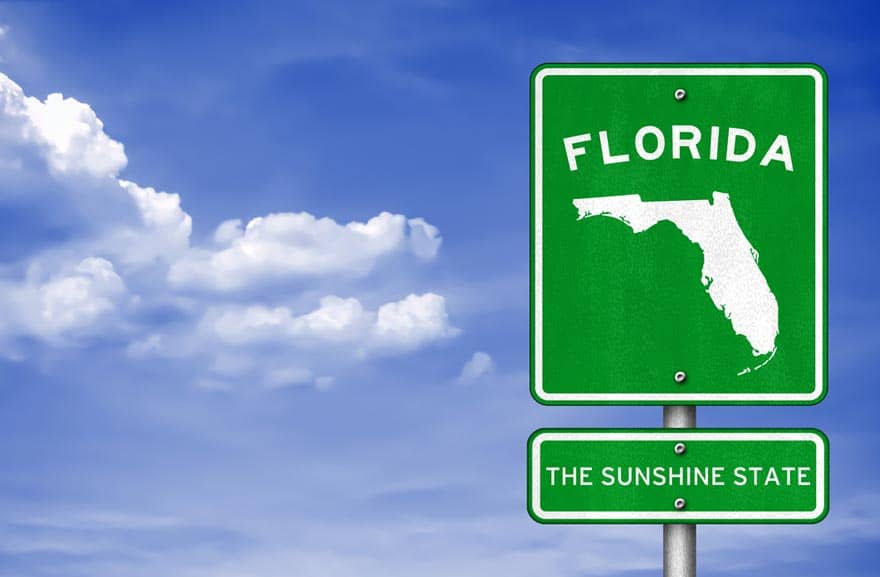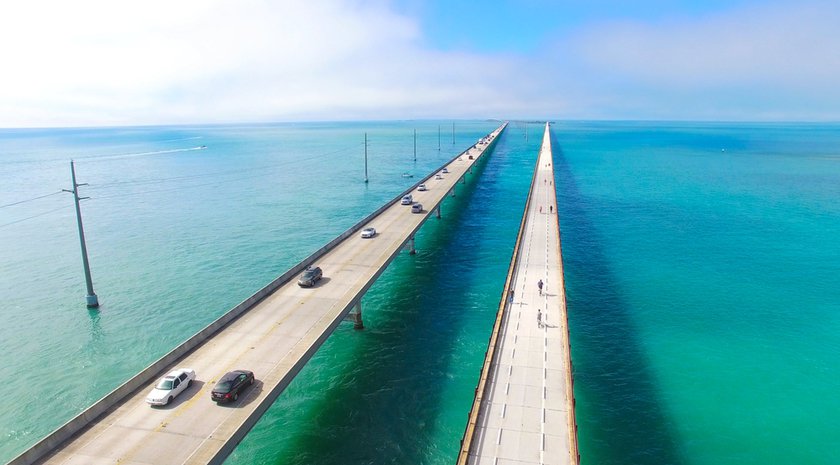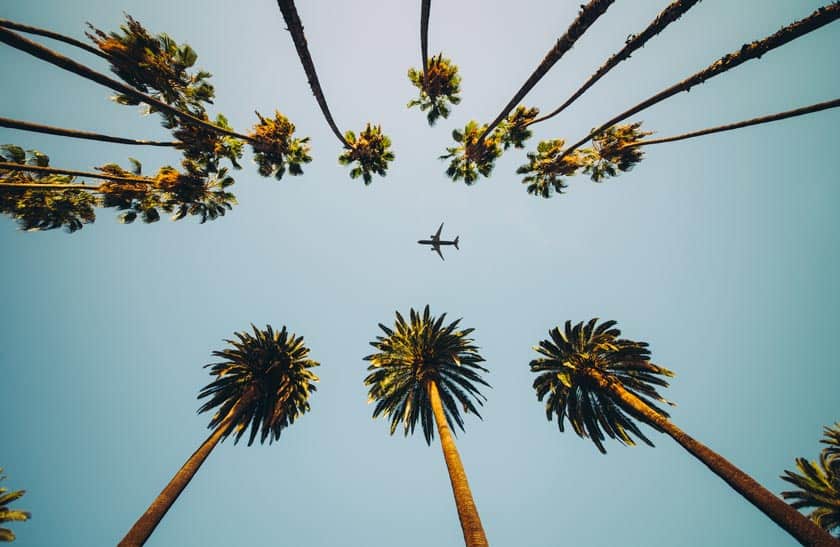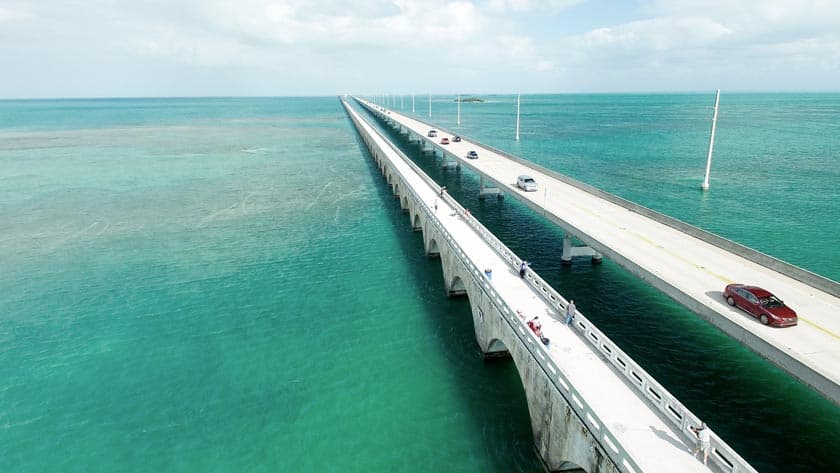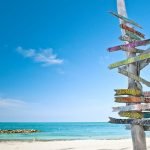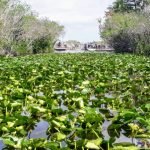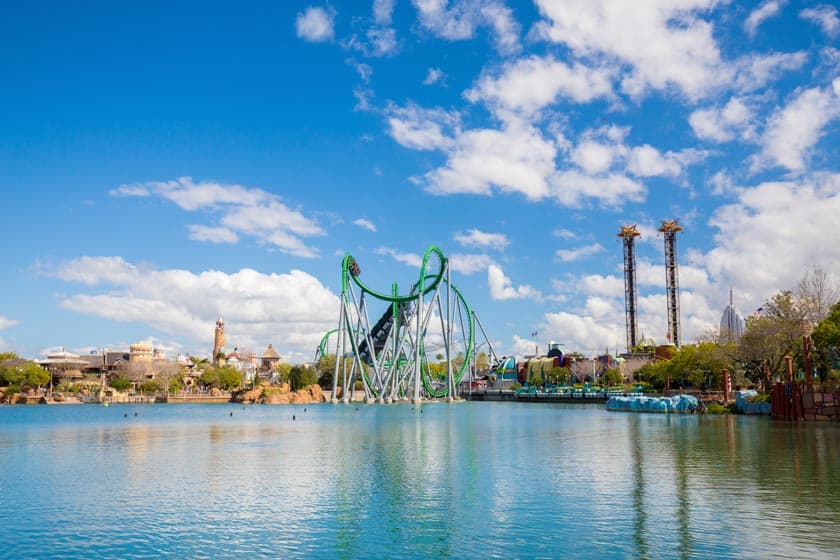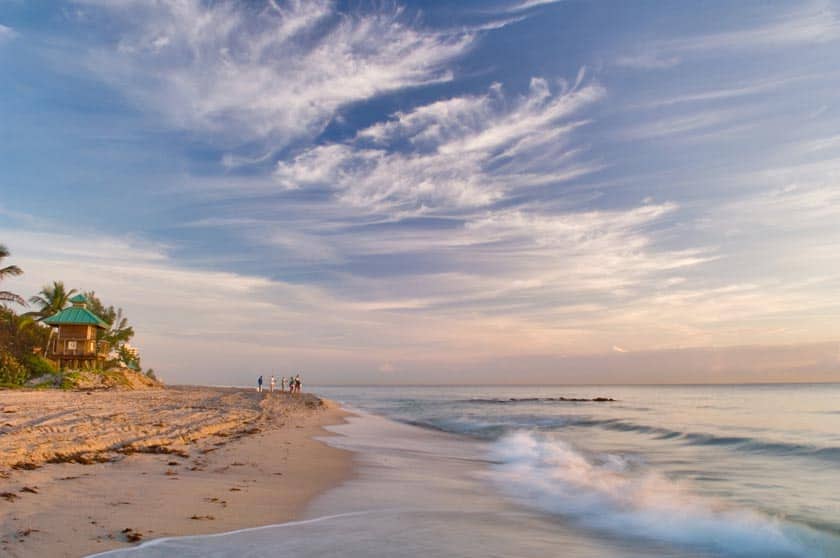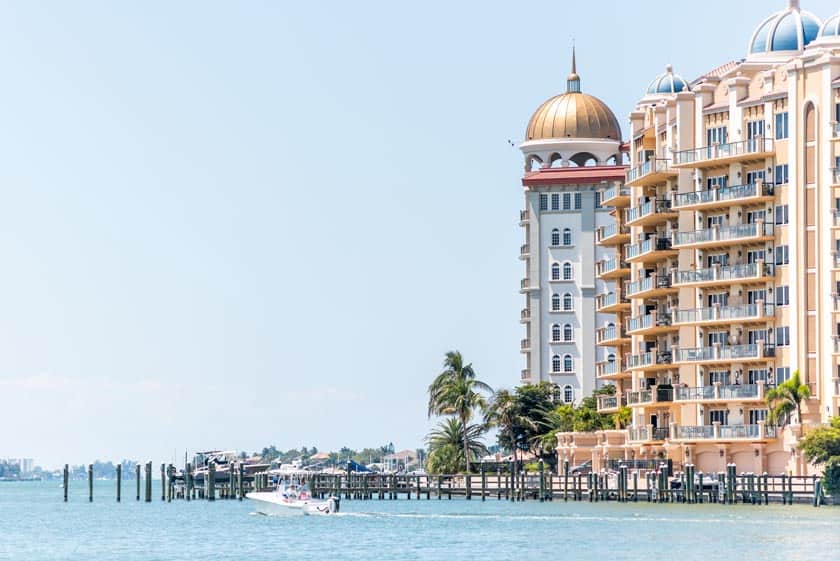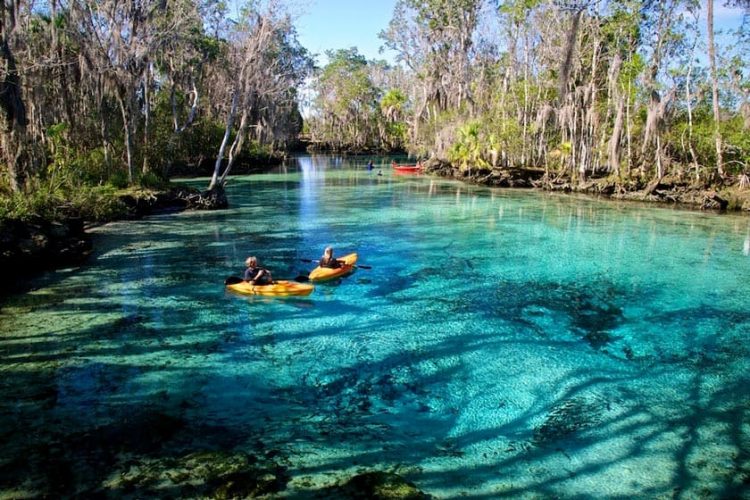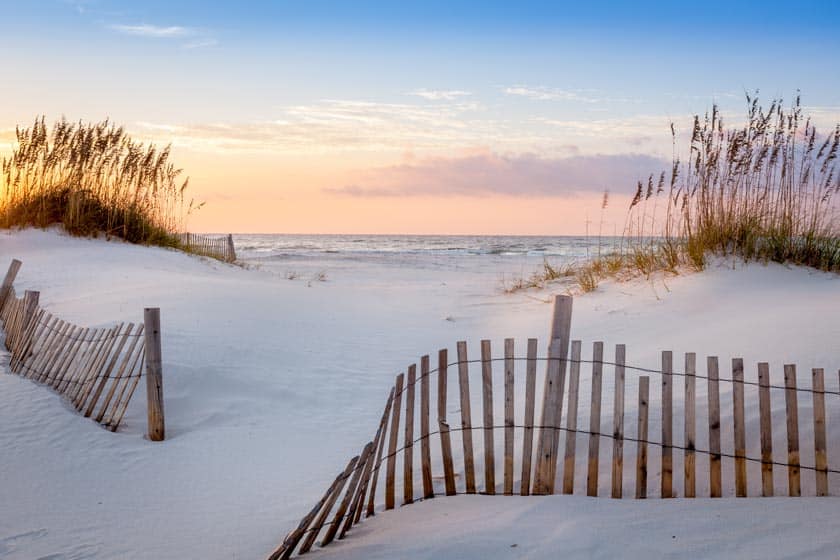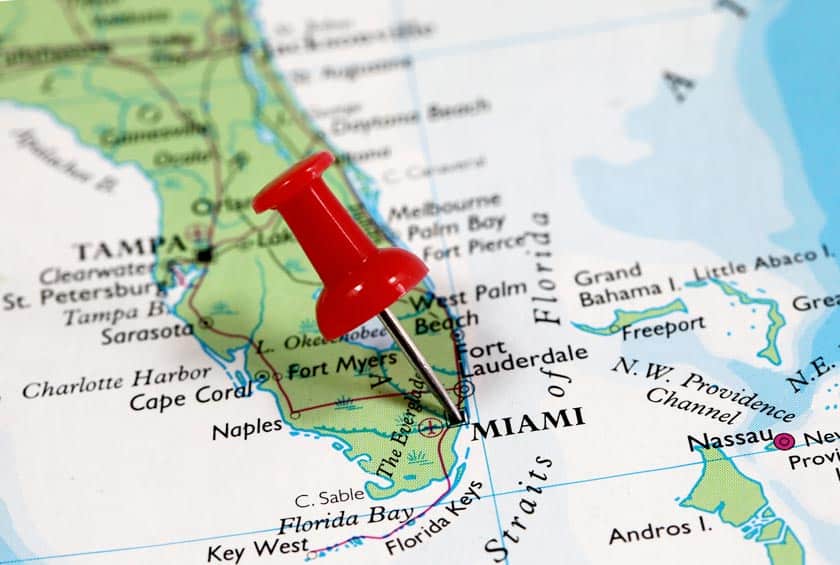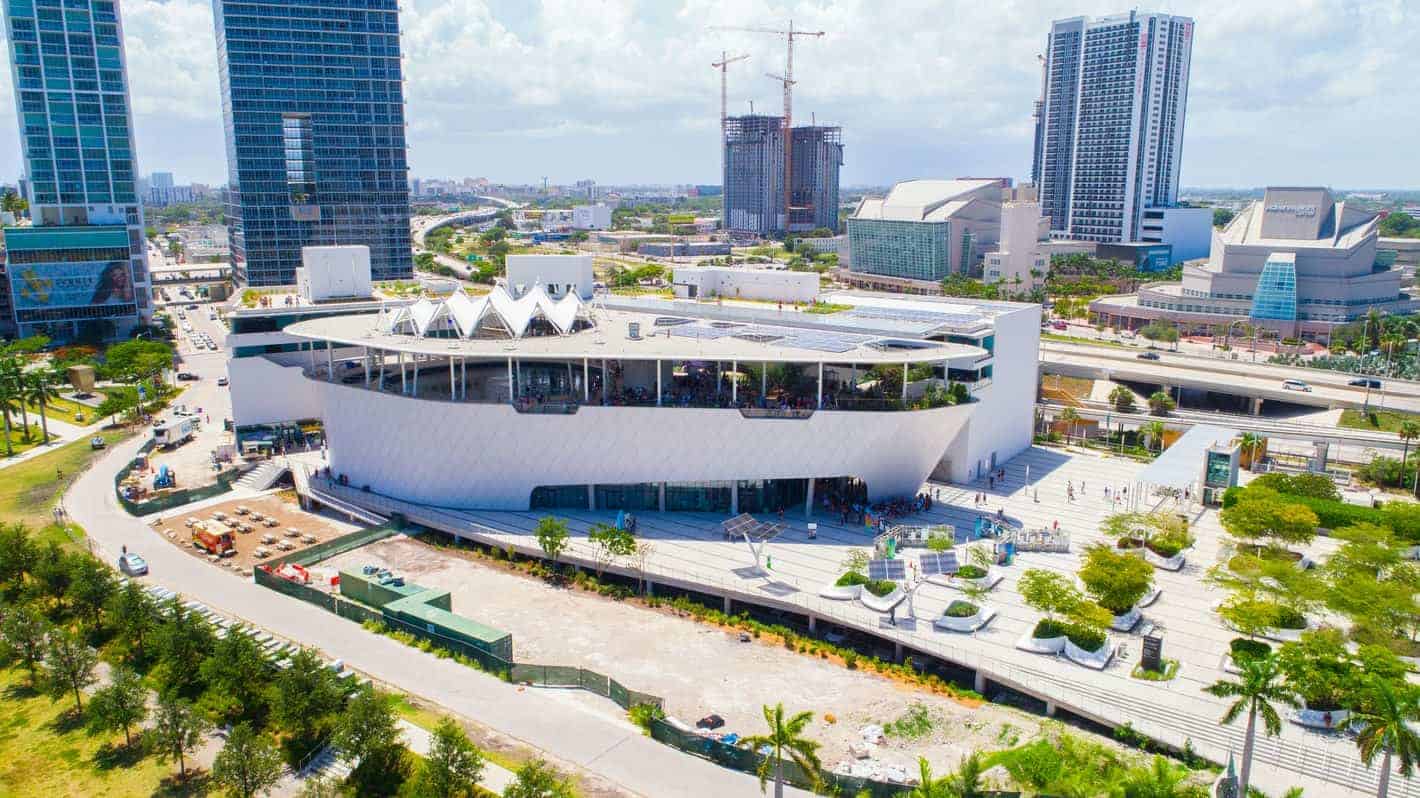Each American state has its own particular charm and personality, but that of Florida, the so-called “Sunshine State”, is truly unique. In fact, although it is totally different from all other U.S. states, Florida is one of the regions with the greatest tourist appeal of all the United States and, at the same time, one of the least known. This dual soul of the Sunshine State is certainly one of its most intriguing aspects, able to attract in one go both the less demanding visitors and those looking for more isolated and less “touristy” attractions.
The most common image of Florida is one dominated by white beaches fringed with palm trees, crystal clear sea, lively nightlife and incredible amusement parks. We cannot say that this is not enough, but there is also much more: a long way from the accommodation facilities there are endless tropical forests, crystal clear rivers and natural springs, mysterious swamps, virgin beaches where nature still retains its wild and primordial charm, islands that give the impression of being at the edge of the world and territories that recall the typical agricultural landscapes of the Deep South.
In short, there are not only the flashy art-déco buildings on the waterfront of Miami Beach and the Orlando Theme Parks, but also Everglades National Park, the Florida Keys, the Apalachicola National Forest, the natural springs where manatees swim, and the remote and un-touristy Panhandle region, as well as, of course, all of Florida’s other famous beaches, each with its own specific characteristics but all united by the same tropical paradise charm.
The purpose of this article is to help the traveler plan the stages of an itinerary in this beautiful state, trying to bring out the main attractions and points of interest in order to plan a trip to Florida.
Contents
- Climate: Best Time to Visit Florida
- How to Get There
- How to Get Around? Exploring Florida by C ar
- What to Do in Florida? Which Stops to Choose for Our Itinerary
- Southern Florida: Miami, the Everglades and the Florida Keys
- Central Florida: the Land of Theme Parks and More
- East Coast: Tropical beaches, Exclusive Towns, History, Racing and Space Launches
- West Coast: Locations Overlooking the Gulf of Mexico
- North Florida: Natural Springs and Traditional Villages
- Panhandle: Northwest Florida Itinerary
- How to Plan a Trip to Florida? Useful Resources
Climate: Best Time to Visit Florida
First, a brief note on Florida’s climate to understand when it’s best to plan a trip to the Sunshine State. The state, as its nickname clearly suggests, is famous for its warm temperatures and bright sunshine, however, it is also known to be very rainy and easily prone to thunderstorms and hurricanes, which hit the territory especially during the scorching summer season.
Although Florida can be visited in any season of the year, the best and most suitable period for a vacation is the one that more or less corresponds to the winter season, roughly from November to April. It’s no coincidence that the sunny swimsuit-and-sunglasses climate that can be found during this period makes Florida one of the most popular destinations for Christmas and New Year’s vacations, as well as for the first few months of the year.
There must be a reason why Florida’s coastal cities and beaches are taken by storm, not only by the many young people, but also by retirees from the Northern States (and Europeans) who come to “winter” here! For more details on the climate in the various zones of Florida please take a look at our articles dedicated to the topic:
How to Get There
Landing in Miami is a good choice, strategic for visiting both the southern tip of Florida and the central area (Orlando and surroundings), but it is a bit more inconvenient if you want to add places on the west coast to your itinerary. It’s nothing to worry about, however: the distances to travel to reach cities like Tampa, Clearwater, Naples, Sarasota or St. Petersburg by car are always less than 5 hours, which in the US standard of driving is actually very little.
If, on the other hand, your vacation is all about amusement parks, it may be convenient to land directly in Orlando and plan the return flight from Miami when the tour of Florida is over. Other airports to take into consideration are Fort Lauderdale and Jacksonville for the east coast, Tampa and St. Petersburg for the west coast.
Finally, it is also possible to insert your visit to Florida in the context of a wider tour of the south of the United States, landing for example in Atlanta (Georgia), New Orleans (Louisiana) or even New York, then reaching the Sunshine State on a long road trip down the East Coast. Especially in this last case, it is clearly necessary to plan the itinerary with a suitable number of days available for the trip.
How to Get Around? Exploring Florida by C ar
Florida is a perfect state for a vacation on the road, since its size makes it very easy to cross both from North to South (in about a day), and from one coast to the other: as we said, for a “coast to coast” a couple of hours are often enough, maximum 4 if you really need to cross the whole state. Another point in favor are its scenic roads: not only those immersed in the typical vegetation of the swamps and tropical forests, but also the Overseas Highway, which is a real dream road.
Be careful though! Unlike other states in the U.S. where you may have been, to drive on some roads that are part of the highway network called the Florida Turnpike you have to pay a toll.
An alternative to renting a car are the Greyhound buses and Amtrak trains, which also connect the main cities from one coast to the other, but with public transport you will have great difficulty in exploring the less touristy areas and you will have to spend a lot of time on board from one stop to the next.
What to Do in Florida? Which Stops to Choose for Our Itinerary
Let’s see now how to organize our tour in Florida, structuring the route by main areas:
Southern Florida: Miami, the Everglades and the Florida Keys
Florida’s southernmost area, with its unique mix of charming cities and natural beauty, is one of the most fascinating regions in the entire state. The main places of interest are Miami, Everglades and the Keys, particularly Key West. Given the proximity between these three destinations, it is not unusual to focus your tour in this area, especially if it is your first time in Florida and you don’t have much time to spare:
-
- Miami: on the east coast is the iconic Miami, the city that is the symbol of the Sunshine State, characterized by wonderful beaches, charming neighborhoods and great liveliness. A stroll down Ocean Drive, South Beach’s main street, dominated by Art Deco buildings and crowded with cafés, eclectic characters and vintage cars, is a must. However, the beauty of Miami is that each neighborhood has its own particularity: some examples? The opulent mansions and waterfront gardens of Coconut Grove, the traditional Cuban spirit of Little Havana, the street art vocation of Wynwood, the distinct look and architectural variety of Coral Gables, the dizzying hypermodern verticality of Downtown, the charm of the natural parks around Key Biscayne… In short, if we have intrigued you and you would like to know more, do not miss our tips and advice on what to do in Miami.
- Everglades National Park: not far from the coast of Miami, we find by far the most famous natural attraction of Florida: Everglades National Park. It is an endless nature reserve that looks like an impressive swamp populated by alligators, herons, pelicans, sea turtles and other animals that we don’t see at home. The most common way (and the most invasive, according to experts) to visit the area is aboard an Airboat, a motorboat that allows you to tour the area on the water’s surface, admiring its amazing ecosystem and giving you the possibility of close encounters with alligators. However, if this type of tour is not for you, you can take a “traditional” tour, walking along one of the various educational trails that start from the surroundings of the Flamingo Visitor Center or the Ernest Coe Visitor Center. These two are the main entrances, but they are not the only visitor centers in the park: depending on the itinerary you have in mind, you can also choose the Shark Valley Visitor Center (the closest to Miami, famous for its “river of glass” visible on a guided tour) and the Gulf Coast Visitor Center, on the western side of the park, perfect for those coming from Naples and surroundings and want to make an excursion by water to Ten Thousand Islands or in the swampy meanderings of the park dotted with mangroves and aquatic plants.
- Florida Keys: taking our tour of Florida even further south, we can travel one of the most striking panoramic roads in the US, the Overseas Highway. In full “on the road” spirit, we can cross the gorgeous Florida Keys, a chain of islands that stretch out for over 100 miles, an open air paradise that is perfect for fishing, snorkeling and scuba diving. There are too many islands to count, but you will have heard of at least some of them
- Key Largo, the diving capital of the world, a paradise for scuba-divers who come to admire its stunning coral reef (John Pennekamp Coral Reef State Park);
- Islamorada, home of Big Betsy, the Giant Lobster. This small town-archipelago comprises several islands, all characterized by beaches of great beauty where you can relax or do water sports;
- Marathon, one of the largest towns in the archipelago, named after the hard work (“the marathon”) of those who built the railroad, later replaced by the Overseas Highway;
- Seven Mile Bridge: one of the most incredible segments of this long scenic highway. Marathon to Little Duck Key for a jaw-dropping drive over the ocean;
- Bahia Honda: known to be the home of some of the most beautiful beaches in all of the Keys. Don’t miss the picturesque view of the old decommissioned railroad that rides the ocean and is lost on the horizon.
- Key West: leaving behind all these islands and continuing to the southern end of the United States, we finally reach the presence of one of the most eccentric and exclusive towns of the state, Key West, the southern terminus of the Overseas Highway. This is literally a place at the edge of the world, whose charm is enhanced by the figure of Ernest Hemingway, who lived here and where he began to write his masterpiece A Farewell to Arms (among many others): in addition to the house where he lived, there are many places on the island that are there to testify to the presence and importance of the American writer. In addition to the beaches, Key West offers visitors the opportunity to see and experience historic buildings, lush gardens, lively bars and especially Mallory Square, the most coveted of the various panoramic terraces, from where you can admire one of the most beautiful sunsets in the whole country.
Central Florida: the Land of Theme Parks and More
Once upon a time, before Walt Disney set his sights on the area to build his incredible citadel of fun, the city of Orlando (which holds the record for the most visits to the state each year) and the entire surrounding swampy area were territories entirely dedicated to agriculture. However, the changes introduced since the 1970s have transformed the entire area into the state’s main destination for mass tourism: the theme park region.
In no other place in the world will you find such large and articulated amusement parks, which is why usually those who come with family or friends to Orlando stay there for at least 2-3 days, investing a good amount of money and a lot of time to experience all possible forms of entertainment.
- This is the land of the immense Walt Disney World, a sort of Disney paradise that includes 4 theme parks (+ 2 water parks): Magic Kingdom, Epcot, Disney’s Hollywood Studios and Animal Kingdom Park, each with its own dedicated concept. Just think that to make a fully satisfactory visit of the Orlando parks you would need to dedicate at least 5-6 days to Disney World alone, practically one per park!
- The main competitor of the huge Disney park is Universal Studios Orlando, the equivalent of Universal Studios in Los Angeles. In addition to many other attractions that a lover of American cinema would not miss for anything in the world, this park is a sort of mecca for all those who love Harry Potter: The Wizarding World of Harry Potter section alone is worth the price of the ticket.
- Among the water parks in Orlando, in addition to those at Disney (Disney’s Blizzard Beach and Disney’s Typhoon Lagoon), I would like to mention SeaWorld Orlando, the best one in the state of Florida, and Discovery Cove, where you can swim with dolphins and snorkel with tropical fish.
These are just some guidelines, but to get a better idea of how to choose and how to organize yourself, take a look at our tips for visiting the best parks in Orlando.
East Coast: Tropical beaches, Exclusive Towns, History, Racing and Space Launches
The East Coast above Miami features a number of small towns with beautiful beaches and tropical palm trees, and each offers something peculiar and interesting. As you move away from Miami towards the north, the coast offers a different (and in some ways unexpected) spectacle to the visitor. Basically, we can divide the coast into 4 parts:
- Gold Coast (from Miami to West Palm Beach). Exclusive locations with European architecture, lush gardens, parties and entertainment everywhere and for all ages, from retirees to the very young. The timeless myth of Florida as we imagine it passes through here!
- Treasure Coast (from West Palm Beach to Vero Beach). So named because of the discovery of a rich treasure from a Spanish galleon that was shipwrecked in 1715. This coast has retained a slightly more authentic look than the tourist towns of the Gold Coast and still has some fairly unspoiled nature reserves.
- Space Coast : the area of Cape Canaveral and the Kennedy Space Center, known mainly for the presence of NASA facilities.
- First Coast: the less touristy, northern end of the East Coast, whose main landmarks are Jacksonville and St. Augustine. Why First Coast? Because, as highlighted by the history and culture of these cities, in the second half of the sixteenth century, this was the landing point of the first European settlers.
But what are the most interesting cities on the East Coast besides Miami?
- Let’s start with the legendary Fort Lauderdale, famous for its beaches and nicknamed the Venice of America due to its many canals crossed by gondolas and boats (if you want to know more read our article on the attractions of Fort Lauderdale);
- Boca Raton, an elegant town characterized by many buildings in Mediterranean Revival style, a ’20s vibe freely inspired by the great European churches and palaces of Spain and Italy;
- Palm Beach, an elite destination on an island with splendid gardens and palaces, luxurious bathing establishments, art galleries and refined architecture; and finally, on the First Coast,
- Daytona Beach, famous both for its 18 miles of golden beach that can also be traveled by car (!) and, needless to say, for its famous car races.
If, however, you’ve had enough of beaches, palm trees and exclusive tourist resorts, on the west coast you will also find 2 interesting alternatives, one on the Space Coast and the other, a bit off the classic itineraries of the state, on the First Coast:
- Kennedy Space Center: the technological facility at Cape Canaveral where NASA launches its spacecraft. Take more than a half day to explore it and admire authentic aircraft and instruments of space travel. The complex is set in a pristine nature preserve, a contrast as stark as it is unique. We talked more about this in our article on how to visit the Kennedy Space Center.
- St. Augustine: a Spanish town dating back to the 16th century, rich in historical evidence, the oldest settlement in the United States. A stop in this charming city means stepping back in time: we talked about it in our article “St. Augustine what to see“, where we indicated the most interesting neighborhoods and attractions not to be missed.
West Coast: Locations Overlooking the Gulf of Mexico
The west coast of Florida, facing the Gulf of Mexico, looks a bit like the sister of the east one, with immaculate tropical dream beaches, bohemian towns, curious fishing villages and breathtaking sunsets. Even on this side of Florida – for those who are animated by a certain desire for novelty – there is a significant presence of virgin beaches to explore outside the usual tourist routes (among many, Captiva Island). Here are the main locations on the coast:
- Tampa: a small, lively and contagious city, the nerve center of Tampa Bay. There is a characteristic nineteenth-century historic Cuban district, with a lot of nightlife and a refined gastronomic offer. Two attractions are not to be missed: Busch Gardens, an impressive amusement park inspired by Africa in the colonial period, and the Museum of Science and Industry, where you will be immersed in reconstructions of particular natural events.
- Sarasota: its name is linked to the history of the Ringling family circus (whose original tent can currently be visited), which saw its fortunes rise and proliferate in these parts. The city is quite rich in stimuli, full of artists, writers and shows with a circus theme and others, and offers a center with many architecturally interesting buildings. For its valuable collection of Baroque art, the Ringling Museum of Art is worth a visit. Obviously worthy of mention are the beaches of Sarasota, especially Lido Key and Siesta Key.
- Fort Myers: less lively than Sarasota but still quite busy. Here you can also find 2 properties that belonged to two historical figures: the Edison Winter Estate and the Ford Winter Estate, both of which can be visited. It is worthwhile to visit the beaches of Estero Island and the small village of Matlacha, a colorful little island in full “Old Florida” style just in front of the nearby Cape Coral.
- St. Petersburg: originally a destination that was particularly attractive to retirees, in recent years it has been able to attract a younger cohort. Here, in addition to the long wonderful beaches, often crowded to the hilt, you can also feed your eyes and mind thanks to the presence of two very important museums: the Museum of Fine Arts and the Salvador Dali Museum, the largest collection of works by the Spanish painter outside Europe.
- Naples: another very interesting destination, both for its beautiful beaches and for its interesting city center characterized by a relaxing tropical atmosphere and colorful houses. Moreover, it is a privileged city for the departure of many excursions, from the Everglades park to Marco Island. To learn more, check out our article on what to see in Naples.
- Clearwater: the town with the “almost perfect” beach – there must be a reason they call it the “Best beach town”! Sunset at Pier 60 – the sunset show from the pier – rivals Mallory Square in Key West for beauty and unforgettable views.
- Tarpon Springs: Many eclectic Florida towns sport European folkloric and architectural influences that may seem a bit out of context to some. A bit like neighboring “Scottish” Dunedin, Tarpon Springs stands out in my opinion: unlike the main city centers of the west coast, it looks like a cute Greek village dedicated to sponge fishing. This cultural transplantation from the other side of the world is a particularly successful one!
North Florida: Natural Springs and Traditional Villages
As one proceeds northward, one enters the region between the peninsular and the Panhandle. Here, the mass tourism that characterizes the eastern and western coastal resorts is much less present: when we were talking about the lesser known Florida, we were referring above all to this area, which unfortunately often remains excluded from the classic tours.
Leaving aside Jacksonville and the First Coast resorts (where you can breathe a totally different atmosphere), it is worth moving to the north-central part up to the western side: in these parts, you’ll find rich tropical forests with mysterious paths immersed in the typical flora of the area, sparkling natural springs with clear waters where turtles and manatees swim, peaceful lakes and rivers fed by spring waters sunk in the vegetation, and urban centers that are as vibrant as only the cities of the Southern states where music is the lifeblood…. but also tiny, sleepy rural villages far removed from the excesses of big cities and left over from a century ago, with small businesses and antiques, historic wooden mansions and Victorian-style buildings with their facades caressed by oak trees.
Here are some tips on what to see:
- natural springs: a delicate habitat for manatees and other protected Florida species, natural springs are among the state’s most beautiful attractions. In truth, there are so many that it is difficult to choose one: the most famous are in the area of Crystal River, Steinhatchee, Cedar Key and Homosassa (on the northwest side). Many tourists, wanting to get away from the beaches, visit the reserves of Three Sisters Springs, Fanning Springs State Park, Ichetucknee Springs State Park and Homosassa Springs Wildlife State Park, but there are also beautiful ones on the eastern side (for example Blue Spring State Park near DeLand). One of the most scenic by far is Devil’s Den Spring in Williston.
- Gainesville: The city of Gainesville is a good intermediate stop for those coming from the east coast to the west coast via the Springs region. Completely different from the coastal cities, Gainesville is home to Florida University and therefore known for the stimulating and youthful atmosphere of its clubs. In addition to the nightlife, Gainesville also offers many hiking opportunities in the surrounding area. One example? The Devil’s Millhopper State Geological Site rainforest.
- Ocala National Forest: this forest is definitely a privileged place for getting in touch with the peculiarities of the local flora and fauna or for water sports. It lacks nothing: hot springs, swampy rivers, lakes, tropical forests and endless expanses of grass. Those with little time can also take one of the roads that cut through the forest.
- traditional villages: there are many hidden in the northern region. They are the historical villages most anchored to the traditions and ways of life of Florida in the past, small towns inhabited by people who have not surrendered to the urban revolutions of the main cities, invaded by skyscrapers and tourist establishments. We mention Micanopy, Palatka, High Springs, Mount Dora, Brooksville, Inverness, all of them worth a visit if they are on your route.
Panhandle: Northwest Florida Itinerary
When people talk about Florida in tourist circles – focused on Miami, Orlando and all the fashionable, modern locations overlooking the sea – they tend to even forget that this region exists. Yet history buffs in search of old, unspoiled (and even somewhat idealized) Florida should head straight north to the region known as the Panhandle, which, because of its proximity to Alabama and Louisiana, looks much more like farm country in the Deep South than any stereotypical image of the Sunshine State.
In this area, in addition to beautiful unspoiled beaches you will find historic farms, sites of historical interest due to the ancient presence of the natives, colonial plantations, Spanish forts, scenic lighthouses, fishing villages and immaculate towns à la Truman Show, wild and unspoiled forests and quite a number of natural springs, especially in the area called Big Bend.
The Panhandle is by far the least touristy area in the entire state, so if you plan on touring the area, it takes some fairly thoughtful and careful planning. Below you’ll find some of the area’s highlights:
- Apalachicola National Forest: this is the largest national forest in all of Florida. Its beaches, swamps, rivers hidden under thick vegetation, lakes and natural springs are a must-see setting for those who love these landscapes.
- Wakulla Springs and other natural springs: not far from the Apalachicola Forest is one of the largest natural springs in the world, Wakulla Springs State Park. In addition to taking a swim in its cold and very clear waters, you can go and discover the ecosystem thanks to very informative boat tours. In addition to Wakulla Spring, the Ponce de Leon Springs State Park, in the hinterland of Panama City, is worth a mention.
- Beaches: the Panhandle’s coastline is the Gulf Coast (however, the eastern part is significantly referred to as the Forgotten Coast), much less known than the crowded coastlines of South Florida. Yet beaches such as Grayton Beach State Park, Pensacola Beach, St. George Island State Park, and Santa Rosa Beach have everything to win over visitors: romantic piers from where you can enjoy the sunset, fantastic sea, endless stretches of white sand… Instead of resorts and skyscrapers, there are white houses and restaurants overlooking the beach. But since tourists prefer Miami or Sarasota, this area remains a paradise for those who want to explore the less-traveled territories.
- The cities: the authentic spirit of Pensacola, a very old city on the Gulf of Mexico, closer in appearance, culture and geography to Louisiana than to the excess, verticality and lights of Miami; the rich Hispanic history and the fantastic canopy roads of Florida’s capital Tallahassee; the beaches and typical restaurants of Panama City Beach, the most popular of the Panhandle’s coastal beach towns.
- A hidden gem: when I mentioned the movie The Truman Show, it wasn’t by accident! Maybe you didn’t know it, but the very white, immaculate setting of the movie starring Jim Carrey was actually Seaside, a village overlooking the Gulf of Mexico, the result of an urban experiment that ideally aimed to unify the community through a pacifying and in some ways alienating architectural project. Did the project work? Who knows! The fact is that the town looks fake, just like in the famous 1998 film.
How to Plan a Trip to Florida? Useful Resources
Here’s a Florida Trip Planner: you can find a series of useful insights if you need to independently organize a trip to Florida and don’t know where to start.
Booking Flights
When preparing your trip, you will need to decide – depending on your itinerary – whether Miami will be the departure and arrival city of your trip or whether you should choose another city. You can then proceed to booking your flights. To find the best available offers it is always advisable to consult the various online resources: in most cases, price comparison sites have more advantageous offers than the individual companies’ websites. Book a flight.
If you decide to land in Miami and fly back from Miami, you can also take advantage of Expedia’s flight+hotel packages, which allow you to save interesting amounts on the combined purchase of the two services. But be careful: the departure and return airports must always be the same, otherwise the offer is not available.
Car Rental
Once you have decided the itinerary and booked the flights, you will have to think about renting a car that will accompany you throughout the road trip. Using the search filters, check that the car is comfortable and spacious enough for your luggage: the sites show the differences in specifications for each model. There is no need to rent a 4×4, especially if you stay on the classic tour route.
The general advice is to always rely on the best known companies (giving an eye to ratings and reviews) and to look for the best prices through the best car rental price comparison sites. If you want to know what they are, go ahead and refer to our tips for renting a cheap car in the USA.
Hotels
I recommend booking hotels in advance, especially in the main stops (Miami, Key West and the most touristic areas of the state) where there is a lot of demand year round, and you risk having to settle for lower quality facilities at prices that are far too high for what is on offer. If you get organized in advance, you can find interesting offers on the main hotel booking websites. To get an idea of what these sites are, take a look at our tips on finding a hotel in the specific ones we have dedicated to the most popular destinations in Florida:
- Tips on where to stay in Miami
- Tips on where to stay in Key West
- Tips on where to stay in Orlando
- Tips on where to stay in the Everglades
Have a look at the general section dedicated to Florida: in the articles dedicated to the cities and minor destinations there is always targeted advice for accommodation.
